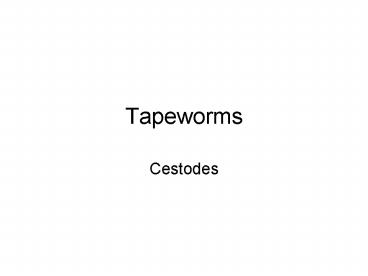Tapeworms - PowerPoint PPT Presentation
1 / 16
Title:
Tapeworms
Description:
Adult worm may get to 10 m long and can shed up to 1 million eggs a day ... These eggs are infective not only for an insect intermediate host, but also for ... – PowerPoint PPT presentation
Number of Views:2375
Avg rating:3.0/5.0
Title: Tapeworms
1
Tapeworms
- Cestodes
2
Diphyllobathrium latum
- Also called the broad fish tapeworm, common in
fish-eating carnivores - Adult worm may get to 10 m long and can shed up
to 1 million eggs a day - Shed spent segments of tapeworm as an indicator
of infection - Infection results from eating second intermediate
or paratenic hosts infected with plerocercoids in
raw or undercooked fish - Symptoms range from none to fatigue diarrhea
- However, approximately 2 of infected individuals
develop megaloblastic anemia, due to the worms
unique affinity for vitamin B12 - Treat with niclosamide or praziquantel
3
Life Cycle
- adult in intestine of definitive host
(piscivorous mammals) ? eggs in feces ? 1-several
weeks for coracidium (larva with a ciliated
epithelium) hatches from egg ? eaten by
freshwater crustacean (1st intermediate host) ?
procercoid in hemocoel ? eaten by fish/frog (2nd
intermediate host) ? plerocercoid in muscles ?
eaten by fish/snake/swine (paratenic hosts) ?
plerocercoid in muscles ? eaten by definitive
host ? adult
4
D. latum Adult
- Scolex showing groove-like bothrium (arrow) used
to grasp the host mucosa - Mature proglottid wider than long
- Eggs are released through the uterine pore, eggs
in uterus
5
D. latum Eggs
- A million eggs/day may be shed in the feces from
each worm - Egg has an operculum, symmetrically oval, and
sometimes have an abopercular knob (arrow) - Structurally they are similar to a trematode egg
- The embryo is undeveloped when the egg is
released from the uterus, and must complete its
development to the coracidium stage in fresh water
6
Taenia pisiformis
- Tapeworm of dogs,
- Scolex and neck (where immature proglottids are
formed), showing armed rostellum and 4 acetabula
(suckers) - Scolex of T. solium would appear similar, whereas
T. saginata lacks hooks - Higher magnification of rostellum, showing circle
of hooks
7
T. pisiformis
- Strobila (body) with immature proglottids being
formed from neck region
8
Taenia saginata and solium
- T. saginata is considered non-pathogenic
- T. solium is pathogenic because of the cysticerci
that can cause serious problems with the human
host
9
T. saginata vs. T. solium
- Species distinguished on the basis of their
scolex, and by counting the number of side
branches of the gravid uterus, numbering gt14 in
T. saginata and lt14 in T. solium - Scolex of T. saginata is absent of hooks
- Scolex of T. solium with rostellum and armed with
hooks - Human infections with the adult worm are acquired
by eating undercooked beef (T. saginata) or pork
(T. solium) infected with cysticerci - Infections with adults usually cause mild or no
symptoms - However, T. solium is quite hazardous, because
its eggs (unlike those of T. saginata) if
ingested by humans release an oncosphere that
develops into a bladder-like cysticercus larva,
which can cause severe disease in the brain or
eye - Also, gravid proglottids may rupture in the
intestinal lumen, resulting in overwhelming
cysticercosis - Treat with niclosamide or praziquantel
10
Life Cycle
- adult in small intestine ? gravid proglottid in
feces ruptures ? embryonated eggs ? ingested by
cow (T. saginata), pig (T. solium), or human (T.
solium) ? oncosphere hatches from egg ?
penetrates gut, enters blood ? cysticercus in
internal organs ? ingested by human ? adult
11
T. saginata vs. T. solium
Proglottids
Scolex
12
Cysticercus of T. solium
- Infected pork, showing 4 cysticerci, each
consisting of a fluid-filled bladder containing
an invaginated, introverted (inside-out) scolex - Note the absence of inflammation around viable
cysticerci - Dead cysticerci elicit a strong inflammatory
response, which can be fatal if occurring in the
brain - Cysticerci can lodge in any organ, and may be
visible as surface swellings if occurring
subcutaneously - Depending on numbers and location, cysticerci in
the brain may cause symptoms of epilepsy
13
Taeniid eggs
- The oncosphere is surrounded by a 2-layered
embryophore, and the thicker outer layer has
prominent radial striations, a diagnostic feature - The surrounding gelatinous layer and capsule
(arrow, top left photograph) are flimsy and often
detach from the striated embryophore, which then
becomes the outermost layer - Eggs of various taeniids (e.g., Echinococcus,
Multiceps, and Taenia spp.) are indistinguishable
from one another and therefore further diagnostic
tests would be advisable, e.g., examination of
scolices and gravid proglottids recovered from
feces - Taeniid eggs on the ground may remain infective
for over 5 months
14
Hymenolepis nana
- Dwarf tapeworm
- Can infect humans, especially children
- 1 in southern US and as high as 97 in Moscow
- Intermediate host is optional which is unlike any
other tapeworm - Humans become infected by ingesting eggs from
rodent or human feces, or by ingesting
intermediate hosts infected with cysticerci - Light infections are asymptomatic
- However, because eggs may hatch in the intestine
of the definitive host, autoinfection can produce
heavy parasite burdens (thousands of worms)
leading in humans to diarrhea and symptoms of
toxicity - Treat with praziquantel
15
H. nana
- Adult with enlarged scolex and neck
- The rostellum is retractable into a sac and is
armed with hooks, not visible - Mature proglottids
16
H. nana Eggs
- Oncosphere with hooks (thin arrow), surrounded by
an embryophore that has polar filaments at either
end (thick arrows) - The outermost capsule is separated from the
embryophore by a gelatinous granular layer - These eggs are infective not only for an insect
intermediate host, but also for the rodent or
human definitive host































